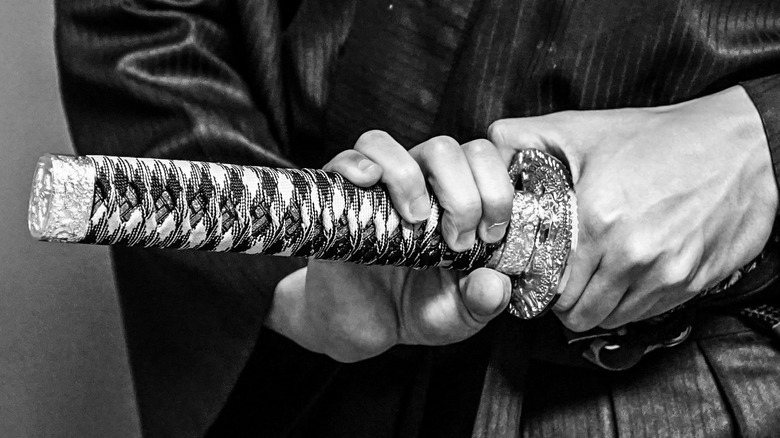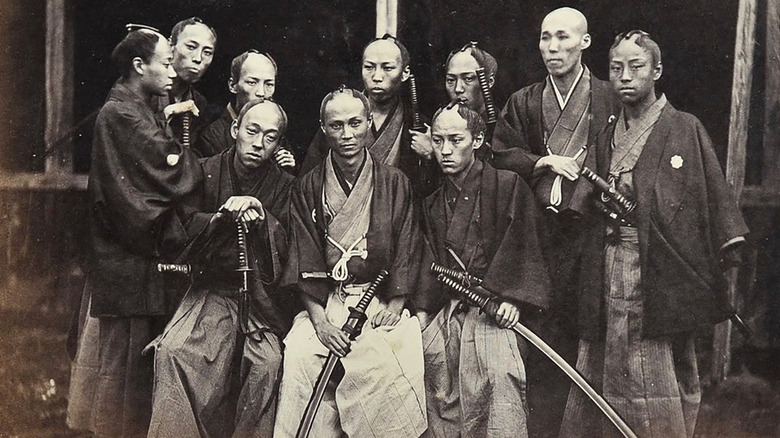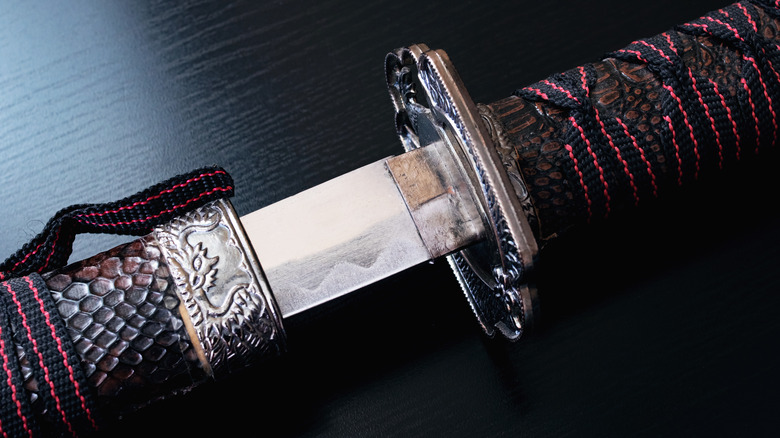Medieval Samurai Criminals Were Subject To A Gruesome Punishment
Japanese samurai are undoubtedly among the most widely romanticized, and widely misunderstood, figures from Japan's medieval Edo era (1603 to 1867). Plenty of anime depict samurai as near-mystical, legendary slayers of demons, and plenty of cosplay give folks the wrong impression about how samurai typically dressed, or the weaponry they commonly wielded. The truth, as always, is quite a bit more mundane.
For instance: the "honor" and "loyalty" commonly envisioned as part of samurai life? They were merely the dogma by which self-serving nobles controlled their for-hire military force, as the Khan Academy outlines. Also, samurai didn't putz around town wearing full battle armor they reserved for all-out-warfare; they wore a fabric kimono, as PBS says. Samurai also didn't hack apart random poor people who gave them wrong looks on the street. There were serious consequences for defying what was, in a highly regimented Edo-era society, ultra-strict rules of conduct and combat. The code of "kirisute-gomen," for example, allowed samurai to kill someone in cases of extreme slander or defamation, as Samurai World explains. But if the murder was found to be unjust? The samurai's entire family would lose all their property and possessions, and the samurai himself would be required to commit suicide.
This is precisely why samurai carried multiple swords. They wore long swords of various lengths, like katana, and a very short, dagger-like sword called a tanto. If the samurai committed a crime requiring suicide as punishment, they could just reach for the tanto tucked into their belt.
If you or anyone you know is having suicidal thoughts, please call the National Suicide Prevention Lifeline at 1-800-273-TALK (8255).
Strict law and order in feudal Japan
Even though samurai reached their height of power during Japan's Edo era, their history goes back to the 12th century, as Crime Reads explains. The entire block of time from the 12th to 19th century could be considered Japan's "medieval era," ruled more by the nation's military lords — daimyō — than its emperor. Over the centuries Japan's social order evolved, and societal classes became more regimented, even hereditary. Law and order became paramount, and the maintenance of that law and order fell to a combination of samurai and local magistrates. This means that samurai didn't only fight in the military; they dispensed peacekeeping — civic justice. As such, they were held to a strict standard of behavior, and subject to more gruesome forms of punishment.
Magistrates and police largely handled law and order among farmers, merchants, artisans, and general riff-raff: the "lower" classes. Samurai more or less policed themselves, within their own, higher social strata. They rarely answered to magistrates, although oddly enough, magistrates were pulled from samurai classes, anyway. So were yoriki (assistant magistrates), who functioned like detectives, and dōshin (regular cops), who wielded billy clubs rather than swords. The lower the law-enforcement rank, the lower the samurai class that the officials were pulled from. The highest level magistrates functioned less like cops and detectives, and more like judges and juries. They operated within the confines of a single city, where they tried cases in court, resolved disputes, and determined sentences.
Disembowelment and decapitation
Content warning: Descriptions of suicide follow.
In general, punishment for crimes across all social classes was pretty severe in medieval Japan, although the details of the punishment varied per class, as Crime Reads explains. Theft, murder, and rape were the big three "unforgivable" crimes, and invoked the death penalty. This was not necessarily because of the effect on the victim, but because the crime defied social order and incurred a debt to society. Bigger debts could only be "repaid," so to speak, with the life of the perpetrator.
But because samurai occupied higher social strata, such acts committed against lower classes were not "crimes" in the same way as crimes within a class, or crimes committed against a higher class. The aforementioned "kirisute-gomen" code was an exception, as Samurai World outlines. If a samurai claimed to have murdered a farmer because the farmer insulted him, and it wasn't true, then that samurai was an embarrassment to his lord and family.
Lowers classes were usually hanged for committing an unforgivable crime, a punishment considered demeaning. Then the person's head would be cut off and put on display. But samurai? They committed "seppuku." They took out their dagger — tanto — and thrust it into their gut to disembowel themselves. Such suicides were conducted with a helper — a kaishakunin — who cut off the samurai's head after he'd disemboweled himself. The goal was to leave a little strip of skin connecting head to throat. This display of skill conferred respect to the kaishakunin.


